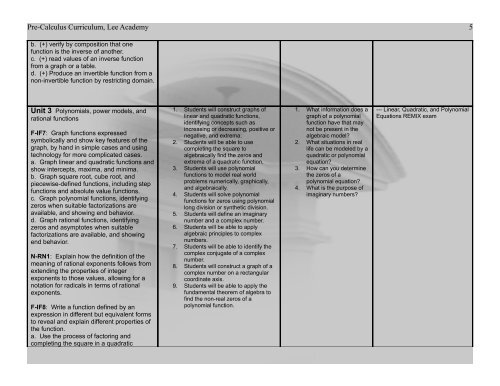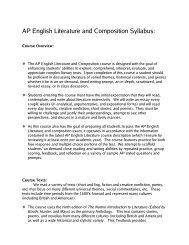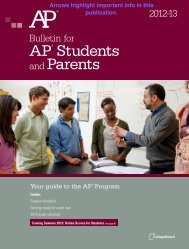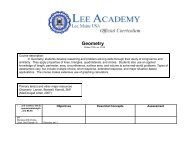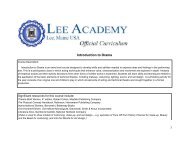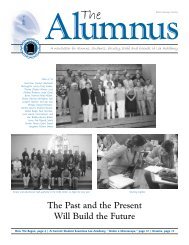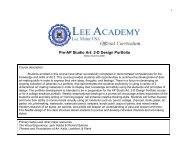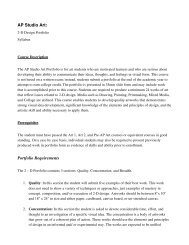Pre-Calculus - Lee Academy
Pre-Calculus - Lee Academy
Pre-Calculus - Lee Academy
Create successful ePaper yourself
Turn your PDF publications into a flip-book with our unique Google optimized e-Paper software.
<strong>Pre</strong>-<strong>Calculus</strong> Curriculum, <strong>Lee</strong> <strong>Academy</strong> 5<br />
b. (+) verify by composition that one<br />
function is the inverse of another.<br />
c. (+) read values of an inverse function<br />
from a graph or a table.<br />
d. (+) Produce an invertible function from a<br />
non-invertible function by restricting domain.<br />
Unit 3 Polynomials, power models, and<br />
rational functions<br />
F-IF7: Graph functions expressed<br />
symbolically and show key features of the<br />
graph, by hand in simple cases and using<br />
technology for more complicated cases.<br />
a. Graph linear and quadratic functions and<br />
show intercepts, maxima, and minima.<br />
b. Graph square root, cube root, and<br />
piecewise-defined functions, including step<br />
functions and absolute value functions.<br />
c. Graph polynomial functions, identifying<br />
zeros when suitable factorizations are<br />
available, and showing end behavior.<br />
d. Graph rational functions, identifying<br />
zeros and asymptotes when suitable<br />
factorizations are available, and showing<br />
end behavior.<br />
N-RN1: Explain how the definition of the<br />
meaning of rational exponents follows from<br />
extending the properties of integer<br />
exponents to those values, allowing for a<br />
notation for radicals in terms of rational<br />
exponents.<br />
F-IF8: Write a function defined by an<br />
expression in different but equivalent forms<br />
to reveal and explain different properties of<br />
the function.<br />
a. Use the process of factoring and<br />
completing the square in a quadratic<br />
1. Students will construct graphs of<br />
linear and quadratic functions,<br />
identifying concepts such as<br />
increasing or decreasing, positive or<br />
negative, and extrema.<br />
2. Students will be able to use<br />
completing the square to<br />
algebraically find the zeros and<br />
extrema of a quadratic function.<br />
3. Students will use polynomial<br />
functions to model real world<br />
problems numerically, graphically,<br />
and algebraically.<br />
4. Students will solve polynomial<br />
functions for zeros using polynomial<br />
long division or synthetic division.<br />
5. Students will define an imaginary<br />
number and a complex number.<br />
6. Students will be able to apply<br />
algebraic principles to complex<br />
numbers.<br />
7. Students will be able to identify the<br />
complex conjugate of a complex<br />
number.<br />
8. Students will construct a graph of a<br />
complex number on a rectangular<br />
coordinate axis.<br />
9. Students will be able to apply the<br />
fundamental theorem of algebra to<br />
find the non-real zeros of a<br />
polynomial function.<br />
1. What information does a<br />
graph of a polynomial<br />
function have that may<br />
not be present in the<br />
algebraic model?<br />
2. What situations in real<br />
life can be modeled by a<br />
quadratic or polynomial<br />
equation?<br />
3. How can you determine<br />
the zeros of a<br />
polynomial equation?<br />
4. What is the purpose of<br />
imaginary numbers?<br />
--- Linear, Quadratic, and Polynomial<br />
Equations REMIX exam


